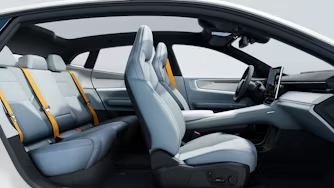International Women’s Day 2023: Outstanding women in the history of the automobile
To mark International Women’s Day (IWD), we give thanks to four incredible women who helped shape the automotive industry in their own unmistakeable ways. These four women have all made an indelible mark on the evolution of automobiles so join us in celebrating their contributions.

Florence Lawrence: The Movie Star turned inventor
To think that Margot Robbie would use her free time to invent revolutionising technology for cars is not impossible, but perhaps highly unlikely. Yet, in the early 1900s, mega movie star Florence Lawrence did just that.
Commonly known as “The First Movie Star” Florence Lawrence starred in over 300 movies throughout her career and was even one of the first women to start her own movie production company (Victor Studios). And it was down to her success and business sense that she made enough money to buy expensive cars and so her interest in cars and automobiles began.
After growing frustrated at being unable to predict what the driver in front of her was going to do - Florence came up with a nifty solution in the form of mechanically operated flaps which extended from the side of the vehicle, indicating right and left turns. And if that wasn’t enough, she also added a flap on the back which let drivers know when she was going to stop. These simple inventions, as you might have guessed, evolvedinto today’s indicators and brake lights.
Sadly, Florence never patented her invention and thus never profited from her invention, but she did believe that her inventions benefited her fellow drivers.
Dorothy Levitt: The Racing Queen with a Pomeranian by her side
With a silk scarf holding her hair in place and her black Pomeranian “Dodo” by her side, Dorothy Levitt was a style icon by anyone’s standards.
Dorothy started her career as a receptionist and somehow became a racing driver which is testament to her brilliance.
Among her many achievements, Dorothy set the Land World Speed Record for women in 1905, as well as a Water Speed Record two years prior (yes, she dabbled in boat racing as well).
She also won the Daily Mail Sweepstake at the Brighton Speed Trials ahead of a male dominated line-up and set record on record in Hillclimb races.
Her unquestionable pizzazz coupled with her brilliant driving, made Levitt a real favourite of the press. While the police were not too happy with her setting speed records on public roads, it made for a good story in the papers. Reports of her many record-breaking victories and occasional run-ins with the law, cemented her as a racing superstar.
Following her great success on the road, she tried her hand at journalism and even published her book The Woman and the Car: A Chatty Little Handbook for Women Who Want to Motor (1909). A great title if you ask us.
In this book, Dorothy shared her expertise in how to choose a car, how to maintain it and carry out small repairs, and most interestingly, practical motoring fashion for women.
One of her handy tips advised women to carry a compact mirror to see the traffic behind them. And just like that, this marked the first known use of a rear-view mirror which as we all know, is standard in all cars today. Worth noting is that she also recommended women to carry a revolver with them – we are glad to say that this never really took off.
Bertha Benz: Pioneer of the first ever long-distance journey
Widely regarded as the father of cars, Carl Benz does not require a lengthy back story or any more time in the limelight. However, his wife Bertha Benz deserves to have her story told.
In the late 1800s, Carl Benz received a patent for his motor car with gas engine operation. Still, as is usually the case with revolutionary technology, he was met with backlash and scepticism. Enter, Bertha Benz.
Fed up with negative opinions, Bertha took matters into her own hands. Without her husband’s knowledge, Bertha enrolled her two sons and pushed the shaky three-wheeled car out of the shed and set off on her own adventure. Her goal was to show the ability and potential of motorised vehicles in a world where horse-drawn carriages were the standard.
Her journey took her from Mannheim all the way to the town of Pforzheim. Travelling on mostly unpaved roads and having to make repairs along the way, the 100 km drive took her just over 12 hours to complete. The unprecedented distance etched her name into the history books as she completed the world’s first long-distance journey in an automobile.
Other than an incredible feat (and an excellent mother-son bonding opportunity), her trip gained worldwide attention and laid the foundation for the future success of motorised vehicles. Thank you, Bertha Benz!
Dr Gladys Mae West: Defying convention and breaking social barriers
Imagine programming a computer to model the earth, receiving a Ph.D. after recovering from a stroke and being one of the brilliant minds that gave us GPS technology. Just one of these would be incredible in itself but Gladys Mae West did all three.
Growing up in rural Virginia in the 1930s, Gladys was the daughter of crop farmers and spent most of her free time working on the family farm. As a young black girl, her future was already laid out for her in many ways and that was to continue working on the farm or perhaps take a job at a local tobacco-processing plant. But Gladys had other plans and her ambition was immeasurable.
As a valedictorian of her high-school class, she gained a full scholarship at Virginia State College where she earned a master’s degree in mathematics. But regardless of her talent, this was still racially segregated Virginia, and the odds were stacked against her.
After years of working as a maths teacher, Gladys was hired as a mathematician by the U.S. Navy in 1956. Working on satellite and computer technology, her spectacular ability for solving complex equations by hand made her stand out in the crowd.
She enjoyed much success in her role and her skill and determination resulted in her being named project manager for an experimental ocean surveillance satellite in 1978. With her leadership, Gladys and her team created GEOSAT, a satellite programmed to create computer models of Earth’s surface.
This meant teaching a computer to account for forces such as gravity and ocean tides, which created a programme able to model the exact shape of the earth. After many updates, this model became today’s modern GPS systems.
Gladys was later inducted into the Air Force Space and Missile Pioneers Hall of Fame and currently holds two master’s degrees and a Ph.D.
These four talented and inspirational women, amongst others, have played important roles in shaping the automobile industry and have paved the way for many more over the years.







